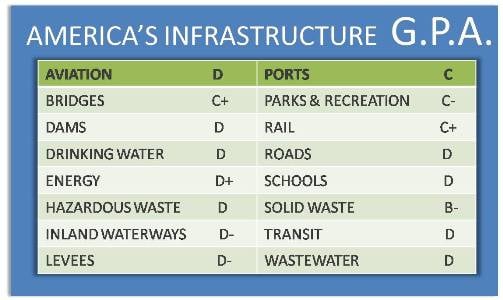Is a D average sufficient enough? Well, to answer that I’d guess you would need to take into account the course, the person being graded or the grading scale. So what if I told you America received a D on their 2013 report card for the current state of the nation’s infrastructure?
Every four years, the American Society of Civil Engineers (ASCE) puts out a Report Card that depicts the current condition and performance of the nation’s infrastructure by assigning letter grades A through F. Below lists the 16 categories and what letter grade they received in 2013:

Each category is evaluated on capacity, condition, funding, future needs, operation and maintenance, public safety and resilience. ASCE estimates that a $3.6 trillion investment is needed by 2020.
ASCE also conducts The Failure to Act (FAS) Series: The Economic Impact of Current Investment Trends in Electricity Infrastructure, which takes a look at the condition of the US’s infrastructure and how it affects the nation’s economic performance. It also points out why it’s important for the nation to continue to invest in infrastructure, and analyzes two types of infrastructure needs: service increasing populations and expanded economic activity by building new infrastructure and maintaining or rebuild existing infrastructure that needs repair or replacement.
According to ASCE’s FAS, the results showed that deteriorating systems have a cascading impact on the nation’s economy, and negatively affects business production, gross domestic product (GDP), employment, personal income and international competiveness. They also project that if investment needs in infrastructure are not met by 2020, the economy is expected to lose almost $1 trillion in business sales, which results in a loss of 3.5 million jobs.
Although deteriorating conditions in each sector affect business productivity differently, this report looks at the overall picture of how the economy will look if the investment gap is met, as well as the consequences if not.
Electricity
Think about how many times out of the day we use our smart phones, iPads, iPods and other devices. Well, in order to keep them powered up, they need to be plugged into the wall to charge. The ever growing demand of electricity without serious investment will cause the economy to suffer if future needs are not addressed to upgrade the nation’s electric generation, transmission and distribution systems.
According to the FAS report, based on current trends, the national electricity infrastructure gap is estimated to be $107 billion by 2020, with shortfalls in grid investments accounting for almost 90 percent of the gap and $95 billion to modernize the grid. Also, by 2020, transmission and distribution infrastructure are expected to account for more than 88 percent of the investment gap, with generation infrastructure representing about 11.5 percent. But, by 2040, according to ASCE, the reverse would happen. Generation infrastructure potentially could be the most costly element of the gap, making up 55 percent of the total, with distribution accounting for 30 percent and 15 percent in transmission.
It is also concluded that electricity interruptions, caused by aging equipment and capacity bottlenecks, could cost businesses $126 billion in lost productivity, causing 529,000 lost jobs by 2020. The interruptions include some of the following:
- Equipment failures
- Intermittent voltage surges
- Power quality irregularities due to equipment insufficiency
- Blackouts
- Brownouts as demands exceed capacity
So, to sum up the conclusions from the FAS report, if electricity infrastructure systems (along with the other categories stated previously) deteriorate or fail to keep up with the changing demand, business costs and prices will go up, as well as cause the production process to become more expansive and divert household disposable income to basic necessities.
